New products at Crocus
by Sarah - May 17th, 2009.Filed under: Crocus, New Products.
New products at Crocus

lemon £24.99
Position: a sunny patio outside, or bright conservatory in winterSoil: moist but well-drained soil. John Innes No2 compost should be used when potting upRate of growth: averageFlowering period: April to SeptemberFlower colour: whiteOther features: exceptionally flavoured lemons and deliciously scented flowers.Hardiness: tender (needs winter protection)Half price was £49.99 A remarkable, heavy-cropping, little tree with glossy, dark green leaves and smooth-skinned, bright golden fruit with exceptional flavour. This clever variety is unique in that it keeps on producing flowers from spring to autumn, so it is possible to have flowers, small, un-ripened fruit as well as ready-to-pick lemons on the plant at the same time. One of the hardiest lemon trees available, it can be grown on a sunny patio in summer, but will need an unheated conservatory or greenhouse to over-winter. The plants may not arrive with fully developed lemons, but they are top-notch, quality plants.Garden care: Ideally grow in a pot which is easily moved from terrace to conservatory, in soil-based compost. Feed every two weeks with a special citrus fertiliser (there is one for summer and another for winter), and pot on or top-dress plants in late winter. Move outside after the risk of frost has passed to a sunny, sheltered patio.
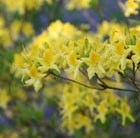
deciduous azalea £15.99
Position: partial shadeSoil: moist, well-drained, humus-rich, acid soil or ericaceous compostRate of growth: fast-growingFlowering period: May and JuneFlower colour: yellowOther features: vivid bonfire shades in autumnHardiness: fully hardySweetly scented, yellow, funnel shaped blooms in May and June and mid green leaves, which take on vivid bonfire shades in autumn. This vigorous, deciduous azalea looks great planted in a mixed border with other evergreen trees or shrubs. As long as it's given moist, well-drained acid soil it will tolerate full sun. Garden care: Avoid planting too deeply. Apply a generous 5-7cm (2-3in) mulch of leaf mould around the base of the plant each spring.Goes well with: Amelanchier lamarckii, Pieris japonica 'Prelude', Enkianthus campanulatus, Digitalis purpurea f. albiflora, Hamamelis mollis, Galanthus nivalis.
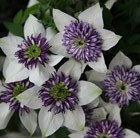
clematis (group 2) £12.99
Position: full sunSoil: fertile, well-drained soilRate of growth: averageFlowering period: May to AugustFlower colour: whiteOther features: attractive dark purple stamensHardiness: fully hardyGorgeous single white flowers which are offset by large, domed bosses of deep purple stamens. The flowers appear in late spring or summer amongst the mid-green, semi-evergreen foliage. An excellent climber for a container or to weave up and through a wall shrub.Garden care: Remove dead and damaged stems before growth begins in early spring, cutting all remaining stems back to where strong buds are visible. Apply a slow-release balanced fertiliser and a mulch of well-rotted garden compost around the base of the plant in early spring.

Honey Bush £9.99
Position: full sunSoil: moderately fertile, moist but well-drained soilRate of growth: average to fast-growing Flowering period: May to JulyHardiness: half hardyAs they unfurl in early spring, the spectacular, grey-green leaves up to 50cm (20in) long, reveal serrated edges that look as though they have been cut with pinking shears. This dramatic architectural shrub makes a stunning specimen for a sunny, perennial border or exotic-style garden in warmer areas of the country. In hot summers, it sends up curious tubular, reddish-brown flowers, but it is the wonderful foliage that stops you in your tracks. To stop it getting leggy, it is best cut back in early spring and the plant will make up to 1.5m growth in one season. To minimise the risk of frost-damage it's important to provide a dry, winter mulch. It is quite late into leaf in spring, so you do need to be patient, but you may be surprised by the amount of growth it will put on late in the year.Garden care: Water frequently until established and apply a generous mulch of well-rotted manure or garden compost around the base of the plant in spring. Although it is is shrub, this plant is best treated as a perennial and cut down to within two or three buds from the base of in early spring. It will shoot back from the base. Protect with a dry winter mulch of straw or bracken especially in cold winters.
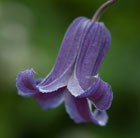
clematis (group 3) £9.99
Position: full sun or partial shadeSoil: fertile, moist, well-drained soilRate of growth: averageFlowering period: July to SeptemberFlower colour: violet-blueHardiness: fully hardyA recent and exciting introduction from Japan, the nodding, bell shaped flowers of this cultivar are carried on sturdy stems and can grow to 5cm long. Their rich violet-blue petals have a light lavender edging, and look lovely over a long period from mid summer to autumn. A semi-herbaceous, non-clinging form, which can be trained onto a trellis, or left to scramble scramble amongst the flower border. An easy to grow clematis which flowers prolifically.Garden care: Cut back the stems to healthy buds at the base of the plant each winter and apply a mulch of well-rotted garden compost around the plant, avoiding the immediate crown.
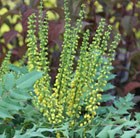
mahonia £9.99
Position: full or partial shadeSoil: moderately fertile, humus-rich, moist or well-drained soilRate of growth: fast-growingFlowering period: November to MarchHardiness: fully hardySlender spikes of bright yellow flowers appear from November to March, above rosettes of large, handsome, dark green, holly-like leaves. The flowers of this lovely, upright, evergreen shrub have a fragrance reminiscent of lily-of-the-valley, and seem to glow in the wintry sunlight. They are followed by bunches of highly ornamental, round, deep purple berries. This mahonia makes a lovely focal point for a shady spot in the garden, where its glossy, architectural leaves can be appreciated all year round. Give it space, as its leaves will spread, and conceal its long 'legs' with spring-flowering bulbs and small, shade-loving perennials. Although it prefers shade, it will tolerate sun as long as the soil remains moist. Garden care: Prune in spring after flowering, reducing overlong, leggy stems to a sideshoot or a whorl of foliage and apply a generous 5-7cm (2-3in) mulch of well-rotted garden compost or manure around the base of the plant.
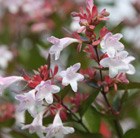
abelia £7.99
Position: full sunSoil: fertile, well-drained soilRate of growth: fast-growingFlowering period: June to OctoberHardiness: borderline hardinessA useful, long-flowering, semi-evergreen shrub for a mixed border. This abelia has attractive, glossy, deep green leaves which it hangs on to for most of the year. From June, it produces masses of small, fragrant, pink-flushed, trumpet-like flowers on arching branches that go on all summer. As its slightly tender, its best grown in the shelter of a wall, towards the back of a border. Ideal for a cottage-style garden.Garden care: Deadhead regularly to prolong flowering. In autumn after flowering lightly trim back the flowered shoots to retain a neat and tidy shape. Remove any dead or damaged wood in April.
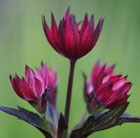
masterwort £6.99
Position: full sun or partial shadeSoil: fertile, moist, preferably humus-rich soilRate of growth: average to fast-growingFlowering period: June to AugustHardiness: fully hardySultry, dark red button flowers, surrounded by a ruff of near-black bracts are produced from June to August above deeply lobed, dark green leaves with almost imperceptible black margins. This stunning, dark red astrantia works equally well in contemporary and cottage-style plantings. For best colour, plant it in fertile, moist soil in full sun.Astrantias have been cultivated in Britain since the 16th century and have numerous common names, such as melancholy gentleman, Hatties pincushion and the more well-known masterwort.Garden care: Astrantias do not like dry soil. Incorporate plenty of organic matter when planting and water well in dry weather, especially newly established plants. Lift and divide large clumps in early spring and apply a generous 5-7cm mulch of well-rotted manure or garden compost around the plant. Divided specimens may take some time to establish since they dont like having their roots disturbed.
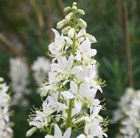
burning bush £6.99
Position: full sun or partial shadeSoil: dry, well-drained soilRate of growth: average Flowering period: JuneHardiness: fully hardyHandsome spires of white or pinkish-white flowers appear from early summer above leathery leaves that smell of lemons, especially when crushed. The flowers are followed by winged seed-pods. This lovely, clump forming perennial gets its common name, burning bush, from the fact that the unripened fruit and the flowers contain an aromatic, volatile oil which may be ignited in hot weather, emitting a delicious aroma. A great plant for the middle of a mixed or herbaceous border.Garden care: Water freely during the growing season. Divide congested clumps in autumn or spring.
love grass £6.99
clematis (group 1) £6.99
African lily £6.99
clematis (group 1) £6.99
shrubby cinquefoil £6.49
blanket flower £5.99
beard tongue £5.99
Armenian cranesbill £5.99
horned violet £5.99
stinking hellebore £5.99






